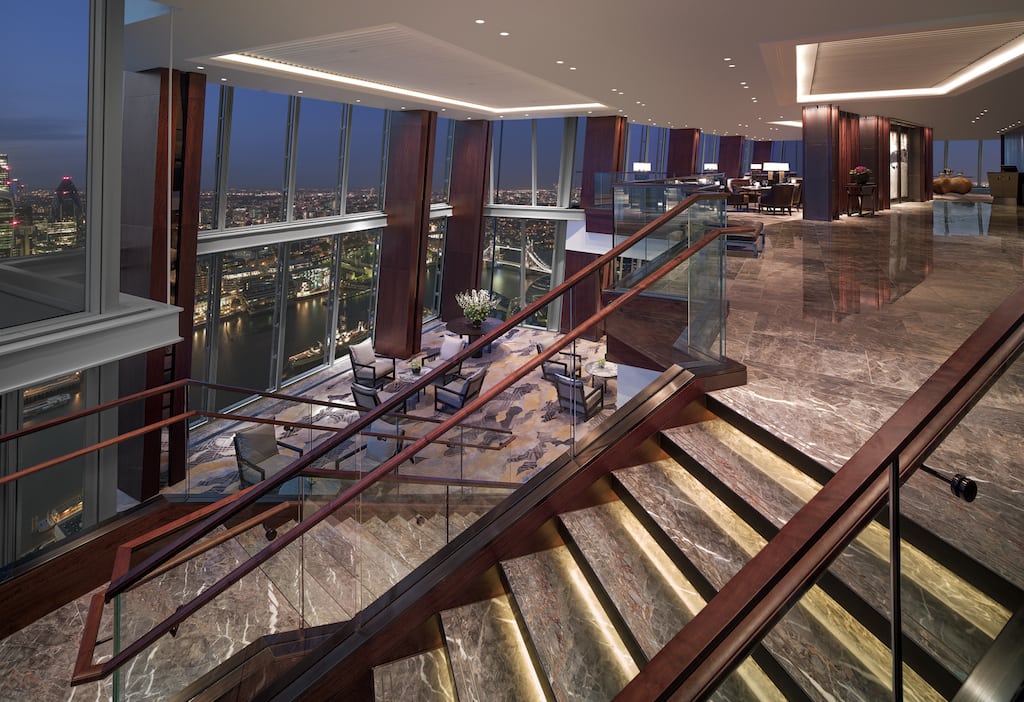Skift Take
The Shangri-La Hotel and The Shard officially sign off on the dramatic resurrection of London's South Bank beginning with the Tate Modern opening at the turn of the millennium.
After speeding 20 feet per second inside an ultra high-speed, double-decker Kone EcoDisc elevator up to the 35th floor, you walk into the upper lobby of the Shangri-La Hotel at The Shard, London heady with anticipation.
Topping out at 1,004 feet, The Shard is the European Union’s tallest building and quite possibly star architect Renzo Piano’s coup de grâce. The Shangri-La Hotel, occupying floors 34 to 52, opened last month with London’s shaggy-haired Mayor Boris Johnson officiating over the ribbon cutting.
The view overlooking the Thames and the panoramic splendor of England’s capital from Battersea Park to Canary Wharf is staggering, as you would expect. In comparison, the double height windows in the upper lobby are perched at a higher elevation than Big Ben (316 feet) and the London Eye (443 feet).
Because The Shard is located in London’s South Bank across the Thames from most of London’s major attractions, that’s the reason why the Shangri-La offers such instantly legendary views.
“Everything is about the view with us,” says Marta Warren, director of communication, while we’re standing 500 feet above bustling London Bridge Station at the foot of The Shard.
Some have questioned the neighborhood as not being tony enough for a Shangri-La property, but that’s part of the whole surreal, jarring and pleasantly disconsonant allure of this hotel and striking building. It’s located within walking distance to Tate Modern and what’s considered London’s somewhat edgier, more “local” area than the touristy West End.
I ask Warren if that poses a challenge for attracting some luxury leisure clientele and corporate groups.
“Everyone who knows London loves the location,” she smiles. “Although, we don’t get as much Middle Eastern business as you might expect because they all want to be near Harrod’s.” Warren then mentions The Shard is 95% owned by the State of Qatar.
There was also a lot of vocal outcry against erecting a building seemingly so incongruous in shape and scale with its historic environs, like a massive glass dagger thrust into the heart of proper English society. Others, however, said the “vertical city” marks London’s official entrance into 21st century urban planning.
“This building is not made with the intention to be aggressive or powerful,” explains Piano in The Guardian. “It is not about priapismo. This building is telling a completely different story. It is celebrating a shift in the idea that growth in a city should not happen by building more and more on the periphery.”
[vimeo 41249245 w=620 h=349]
The 202 guest rooms are housed inside the 18 floors immediately above the upper lobby. The north and east facing “Iconic City View” rooms offer the best 180-degree postcard panoramas. From the west side you can see some of the Thames, but if you’re facing south you might as well close your drapes for all the drama the views of Kent, Surrey and Sussex have to offer.
The furnishings are severely subdued with warm earth tones and a hint of Asian motifs, like the delicate cherry blossom and water lily patterns woven into the fabrics.
Warren says not everyone has been a fan of the hushed decor, and I’m starting to get the sense that you have to put up with a lot of public BS when you open a modern hotel in London.
“We don’t really care about ‘style,’ or what some people might deem as style,” she explains. “We’re not celebrity driven. We’re all about understated elegance and the comfort of our guests.”
To be sure, while walking through the guest rooms, quiet hallways paneled in sycamore, and the meeting salons on level 34, there is an all-pervasive sense of calm high above the din of the city. In the main restaurant TĪNG, derived from the Chinese word for “living room,” everyone is speaking in hushed tones while sipping 30 varieties of teas, or hovering over their Hainanese chicken.
For most guests, according to Warren, that peaceful reverie is the Shangri-La’s most potent selling point.
Above the guest rooms, an infinity-edge pool on level 52 opens in August. On the same floor, the intimate GŎNG lounge and champagne bar is still under construction. This will quite possibly be the most romantic watering hole, or at least the best place to have an affair in London, because of the exquisite views and lack of walk-by traffic.
Leaving the Shangri-La, you gird yourself for the crush outside. To access the top viewing platform, you enter the building’s 2nd floor welcome center where you learn factoids like how The Shard was built with 95% recycled materials.
Much has been written about the multiple indoor and open-air decks at the building’s apex, branded as The View from The Shard, which have been open for over a year. At $50 a pop to access this glassy aerie, it’s surprisingly packed with tourists on a cloudy English day in spring. The views are jaw-dropping for sure, but after enjoying the ephemeral quality of decorum and civility inside the Shangri-La, the rooftop of The Shard has a bit of a theme park ambience.
Still, if you’re here, you kind of have to go all the way to the top. You really can’t beat the view.
Greg Oates covers hotel/tourism development and travel brand media. He has toured over 1,000 hotels in 50+ countries. email / twitter
Have a confidential tip for Skift? Get in touch
Tags: los angeles, shangri-la
Photo credit: The mezzanine-style upper lobby and special event floor below occupy levels 34/35 with one contiguous wall of glass connecting them. Shangri-La Hotels
